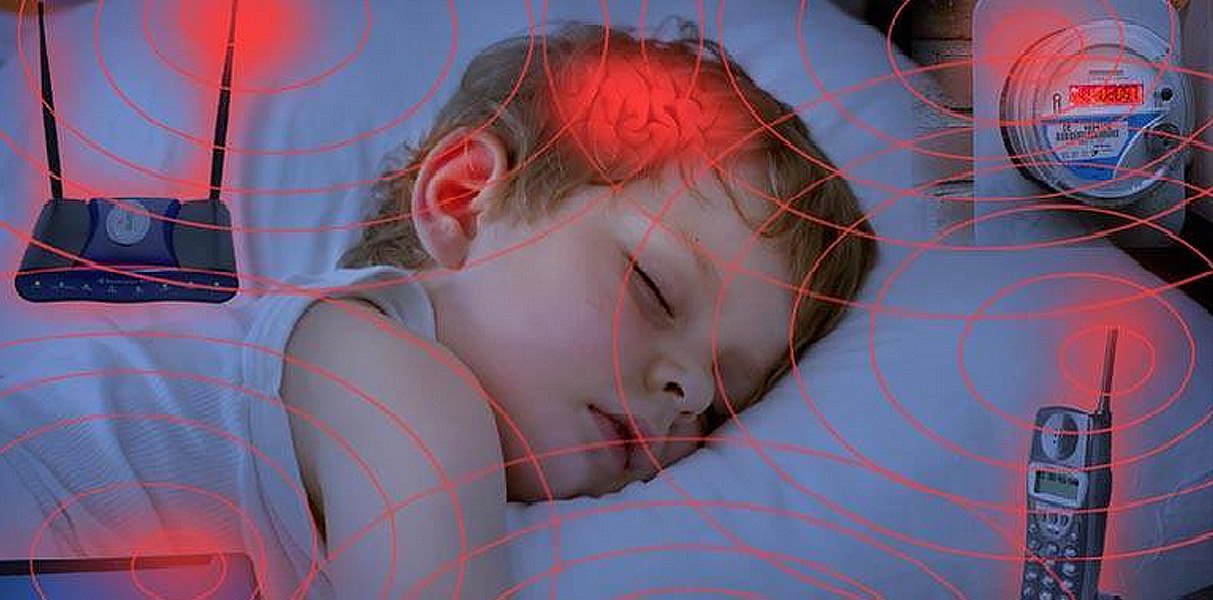Scientists warn of danger of elestosmog
Scientists warn of the danger of eslectrosmog. In the Parliamentary Assembly. Resolution 1815. Potential hazards of electromagnetic fields and their effects on the environment. (2011) VIEW PDF
– Public Summary Bioinitiative 2012 (2012) VIEW PDF
– Bioinitiative Public Summary Update 2014-2017 (2014-2017) VIEW PDF
– EUROPAEM Guide for the prevention, diagnosis and treatment of diseases related to EMF fields – EMF View PDF
– International Agency of Research of Cancer, Resolution (2011) VIEW PDF
– Framework Conditions for Technical Measurements (2015) VIEW PDF
– Technical standard of measurement in Baubiologie (2015) VIEW PDF
– Indicative values in Baubiologie (2007) VIEW PDF
And many more, which should not be forgotten and should be considered as a global risk alert.
INTENATIONAL APPEAL
Scientists Call for Protection from Non-Ionizing Electromagnetic Field Exposure
SCIENTISTS WARN OF ELECTROSMOG DANGERSCIENTISTSWARN OF ELECTROSMOG DANGER: His Excellency Antonio Guterres, Secretary-General of the United Nations. Honorable Dr. Tedros Adhanom, Director-General of the World Health Organization. Honorable Erik Solheim, Executive Director of the United Nations Environment Programme. Member States of the United Nations.
We are scientists
Dedicated to the study of the biological and health effects of non-ionizing electromagnetic fields (EMF). Based on the research reviewed and published in scientific journals. We have a serious concern regarding the ubiquitous and increasing exposure to electromagnetic fields. Generated by electrical and wireless devices.
These include – but are not limited to – radiofrequency radiation (RFR) emitting devices. Such as, for example, mobile and cordless phones and their base stations, Wi-Fi. Also, transmitter antennas, smart meters and baby monitors. As well as, electrical devices and infrastructures. Used for the supply of electricity that generatevery low frequency electromagnetic fields (ELF EMF).

Scientists warn of danger of electrosmog: Numerous recentscientific publications have shown that electrosmogs can be dangerous . EMF affect living organisms. At levels well below the majority of international and national guidelines. Effects include increased risk of cancer, cellular stress. In addition, increased damaging free radicals, genetic damage, structural changes. As well as, functional changes of the reproductive system, deficits in learning and memory, neurological disorders . Likewise, of the negative effects on the general welfare of human beings.
The damage goes beyond the human species
As there is increasing evidence of harmful effects on both plants and animals.
These results justify our appeal to the United Nations (UN) and to all member states of the world. To encourage the World Health Organization to play an important leadership role in promoting the development of guidelines for EMF. What protect the population, as well as to promote precautionary measures. Also, to educate the general public about the health risks. Especially for children and in the period of fetal development. By failing to take action, WHO is failing inits role as the international agency responsible for public health.
International guidelines for non-ionizing EMFs are inadequate
Scientists warn of the danger of eslectrosmog. The different The agencies responsible for setting safety standards have not been able to impose the necessary guidelines. To protect the public in general and children in particular who are more vulnerable to its effects.
The International Commission on Non-Ionizing Radiation Protection (ICNIRP) established guidelines in 1998. Guidelines for limiting exposure to time-varying electric, magnetic and electromagnetic fields (above 300 GHz)”.
These guidelines are those accepted by the WHO and by many countries around the world. WHO is campaigning for all nations to adopt these ICNIRP guidelines. In order to achieve international harmonization.
In 2009, ICNIRP issued a communiqué reaffirming its 1998 guidelines. Reporting that the scientific literature published since then “has not presented evidence of any adverse effects at levels below the basic restrictions. It therefore requires an immediate revision of its guidelines on limiting exposure to high frequency electromagnetic fields.”
ICNIRP continues to this day to make these claims, despite mounting scientific evidence to the contrary. Our opinion, therefore, is that:
“Since the ICNIRP guidelines do not take into account the effects of long-term low-intensity exposure, they are insufficient to protect public health.”
The WHO also adopted the classification of the International Agency for Research on Cancer (IARC).
This classification establishes that electromagnetic fields (EMF) are a possible human carcinogen (group 2B).
- For low-frequency electromagnetic fields (EMF: ELF) in June 20o1
- For radiofrequency radiation(RFR) in May 2011.
Despite both conclusions of the IARC
WHO continues to maintain that there is insufficient evidence to justify lowering these quantitative exposure limits.
Likewise, since there is controversy about the rationale for establishing standards to avoid adverse health effects. It is recommended that the United Nations Environment Programme (UNEP). For that, convene and fund an independent multidisciplinary committee. To explore the pros and cons of alternatives to current practices. That could substantially reduce human exposure to RF and ELF fields.
The deliberations of this group must therefore be conducted in a transparent and impartial manner.
On the other hand, it is essential that the iindustry to participate and cooperate in this process. However, it should not be allowed to bias its procedures or conclusions.. Consequently, this group should transmit its analysis to the UN and WHO to direct preventive action.
Scientists warn of the danger of electrosmog. Colectively we also ask that
1. Children and pregnant women should be protected;
2. Regulatoryguidelines and standardsneed tobe tightened;
3. Manufacturers should be urged to develop safer technology;
4. Utilities responsiblefor the generation, transmission, distribution and supervision of electricity must maintain adequate power quality. And ensure proper electrical wiring to minimize damaging ground current ;
5. The public must be well informed
About the potential health risks of electromagnetic energy and instructed on harm reduction strategies.
http://www.icnirp.org/cms/upload/publications/ICNIRPemfgdl.pdf
http://www.icnirp.org/cms/upload/publications/ICNIRPStatementEMF.pdf
http://monographs.iarc.fr/ENG/Monographs/vol80/
http://monographs.iarc.fr/ENG/Monographs/vol102/
6. health professionals
Since scientists warn of the danger of eslectrosmog. They should be educated about the biological effects of electromagnetic energy. And they should be provided with thenecessary training for the treatment of patients with electromagnetic sensitivity;

exposure to electrsomog
7. Governments should provide training .
And allocate funds for research on electromagnetic fields and health . In addition, it should be independent of industry and they should urge industry to cooperate with researchers.
8. The media should publicize the experts’ financial relationships with the industry .
In citing their views with respect to the health and safety aspects of EMF-producing technologies, the following are some of their views
9. white zones (radiation-free areas) should be established.
Date of the next version
: August 2017.
Current list of signatures published in the English version at www.emfscientist.org.
Inquiries can be made through Elizabeth Kelley, M.A., Director, EMFscientist.org , info@EMFScientist.org.
Note: the signatories of this appeal have signed it on a personal level, providing their professional affiliations. But this does not necessarily mean that it coincides with the point of view of their employers. Or that of the professional organizations to which they are affiliated.
Citations:
http://www.icnirp.org/cms/upload/publications/ICNIRPemfgdl.pdf
http://www.icnirp.org/cms/upload/publications/ICNIRPStatementEMF.pdf
http://monographs.iarc.fr/ENG/Monographs/vol80/
http://monographs.iarc.fr/ENG/Monographs/vol102/
PARLAMENTARY ASSEMBLY
Potential hazards of electromagnetic fields and their effects on the environment
Scientists warn of the danger of electrosmog:
1. The Parliamentary Assembly has repeatedly stressed the importance of the commitment of States. To preserve the environment and environmental health. As indicated in numerous charters, conventions, declarations and protocols. Since the United Nations Conference on the Human Environment and the Stockholm Declaration (Stockholm, 1972).
The Assembly refers to its previous work in this area, including:
- Recommendation 1863 (2009) on Environment and Health (Environment and Health)
- Recommendation 1947 (2010) on noise and light pollution.
- In addition, in general, Recommendation 1885 (2009 ) for the development of an additional protocol to the European Convention on Human Rights on the right to a healthy environment.
- And Recommendation 1430 (1999) on access to information, public participation in decision-making. As well as access to justice in environmental matters (Application of the Aarhus Convention).

2. The potential health effects of very low frequency magnetic fields associated with power lines and appliances are being investigated and are the subject of intense public debate. According to the World Health Organization, electromagnetic fields of all frequencies are becoming more prevalent and are increasingly influencing our environment, increasing concern and speculation. Scientists warn of the danger of electrosmog everyone is exposed to varying degrees of electromagnetic fields whoselevels will continue to grow with advances in technology.
3. The cell phone
It is now spread all over the world. Wireless technologyis based on an extensive network of fixed antennas or base stations. It transmits information in the form of radio frequency signals. There are more than 1.4 million base stations in the world. And their number increases significantly with the introduction of third-generation technologies. Other wireless networks that enable high-speed Internet access and other services. Such as wireless local area networks, they are becoming increasingly popular. In homes, offices and many public places (airports, schools, residential and urban areas). With the number of base stations and wireless networks, the public’s exposure to radio frequencies is also increasing.
4. If the electric and electromagnetic fields of certain bands of the spectrum have fully beneficial effects, which are used in medicine, other non-ionizing frequencies, whether extremely low frequency, power lines or certain high frequency waves used in the field of radar, telecommunications and mobile telephony. All of them appear to have more or less harmful potential non-thermal biological effects on plants, insects and animals, as well as on the human body when exposed to levels below official thresholds.
5. Regarding rules or limits
As Scientists warn of the danger of eslectrosmogemissions of electromagnetic fields of all types and frequencythe Assembly recommended the application of the ALARA principle (as low as reasonably achievable), i.e., the nThe level as low as reasonably achievable. Taking into account not only the so-called thermal effects, but also athermal or biological effects. emission or radiation of electromagnetic fields. In addition, the precautionary principle should be applied when the scientific assessment does not determine the risk with sufficient certainty. Especially because, given the increasing exposure of the population – particularly themost vulnerable groups such as youth and children– the human and economic cost of inaction could be very high if early warnings are ignored.

6.The Assembly regrets
Lack of response to known or emerging environmental and health risks. And the almost systematic delays in the adoption and implementation of effective preventive measures, despite requests of application of the precautionary principle. And of all the recommendations, declarations and numerous regulatory and legislative developments. Wait for solid scientific and clinical evidence before taking action. To prevent the known risks can lead to very high health and economic costs. As was the case in the past with asbestos, leaded gasoline and tobacco.
7. In addition, the Assembly notes that the problem of electromagnetic fields or waves. As well as, its potential impact on the environment and health is obviously comparable to others current problems. Such as drug marketing authorization. And also chemicals, pesticides, heavy metals or genetically modified organisms. Therefore, [la Asamblea] stresses the crucial importance of the independence and credibility of the scientific body of knowledge. To obtain a transparent and objective assessment of potential adverse effects on the environment and human health.
8. In view of the above, the Assembly recommends to the member states of the Council of Europe,
8.1 in general terms: scientists warn of the danger of electrosmog
8.1.1. Take all reasonable measures to reduce exposure to electromagnetic fields, especially to radiofrequencies emitted by cell phones. And in particular exposure in children and young people, for whom the risk of head tumors seems to be higher;
8.1.2. Reconsider the scientific basis for current EMF exposure standards. Set by the International Commission on Non-Ionising Radiation Protection. That it has serious deficiencies, and apply the ALARA (as low as reasonably achievable) principle. That is, the lowest level reasonably possible, both for thermal effects and for athermal or biological effects of electromagnetic emissions or radiation;
They also recommend:
8.1.3. Implement information and awareness campaigns on the risks of potentially harmful long-term biological effects on the environment and human health. Aimed especially at children, adolescents and young people of reproductive age;
8.1.4. Pay special attention to “electrosensitive” people affected by a syndrome of intolerance to electromagnetic fields. As well as the adoption of special measures to protect them. Including the creation of “white zones” not covered by wireless networks;
8.1.5. Increase research efforts on new types of antennas, cell phones and devices such as DECT. In order to reduce costs, save energy and protect the environment and human health. In addition, to promote research. And the development of telecommunications based on other technologies that are just as effective, but less harmful to the environment and health;
8.2 Individual use
From cell phones, DECT cordless phones, WiFi, WiMAX and WLAN to computers and other wireless applications, such as baby monitor intercoms, scientists warn of the danger of electrosmog:
8.2.1 Establishing prevention thresholds. Taanto for long-term indoor microwave exposure levels [de los edificios]. In accordance with the precautionary principle, no higher than 0.6 volts per meter [≅ 0.1 μW/cm²] and reduce it in the medium term to 0, 2 volts per meter [≅ 0.01 μW/cm²];
8.2.2 Implement all necessary procedures. For risk assessment as well as, for any new form of device before allowing its commercialization;
8.2.3 Introduce a clear labeling system . Thus, indicating the presence of microwaves or electromagnetic fields. And noting the Transmitting Power or the “Specific Absorption Rate” (SAR) of the device. As well as, the health risks related to their use;
8.2.4 To inform about the potential health risks of DECT cordless telephones, baby monitoring intercoms . And other household appliances that continuously emit pulsed microwaves, when all electrical devices are permanently left in standby position. And recommend the use of corded telephones in homes or, failing that, models that do not permanently emit pulsed waves;
8.3 Protection of children
8.3.1 Design, within the scope of the different ministries (education, environment and health), programs of action to improve the quality of life of the population.nformation campaigns aimed at teachers, parents and children to warn them of the specific risks of early, indiscriminate and prolonged use of cell phones and other devices that emit microwaves;
8.3.2 Giving preference, for children in general and especially in schools. [“école”: includes pre-school, primary and secondary education] and in classrooms, to wired internet access systems [i.e. avoiding wireless Wifi] and to strictly regulate the use of students’ phones on school premises;
8.4 Planning of power lines and base stations for mobile telephone antennas
8.4.1 Take urban planning measures that require a safety distance between power lines and other electrical installations and dwellings;
8.4.2 Apply strict safety standards regarding the sanitary impact of electrical installations in new houses;
8.4.3 Reduce the permissible threshold for antennas in accordance with the ALARA principle and install global and continuous monitoring systems for all antennas;
8.4.4 Determine the location of any new GSM, UMTS, WiFi or WiMax antenna. Not only based on the interests of the operators, but also in consultation with local authorities and residents or associations of affected citizens;
8.5 Style of risk assessment and precautions to be taken
8.5.1 Risk assessment should focus more on prevention;
8.5.2 Improve the risk assessment criteria and the quality of the assessment by creating a standard risk scale, making it mandatory to indicate the level of risk, having various risk scenarios studied, taking into account compatibility with real life conditions;
8.5.3 Takeearly warning scientists into account and protect them;
8.5.4 Formulate a human rights-based definition of the precautionary principle and the ALARA principle;
More precautions to take:
8.5.5 Increase public funding for independent research. Especially through corporate donations. And of taxes on products that are subject to public study for health risk assessment;
8.5.6 Create independent commissionsfor the allocation of public funds;
8.5.7 Mandatory transparency in lobbying;
8.5.8 Promote pluralistic and controversial discussionsamong all interested parties. Including civil society (Aarhus Convention).
1 Text adopted by the Standing Committee, acting on behalf of the Assembly,on May 27, 2011(see Doc. 12608, report of the Committee on Environment, Agriculture and Territorial Affairs, rapporteur: M. Huss).
2 Translator’s note: This Resolution proposes to lower the legal exposure limits by almost 1,000 times, since Spanish state legislation currently fails to distinguish between indoor/outdoor exposure of buildings or dwellings, and does not consider non-thermal and long-term effects.





